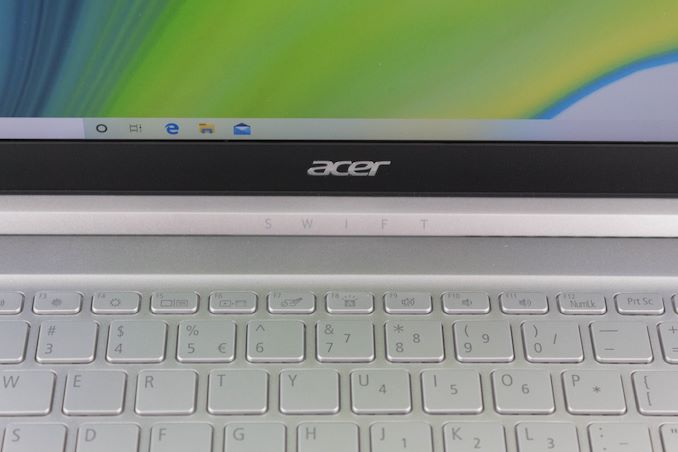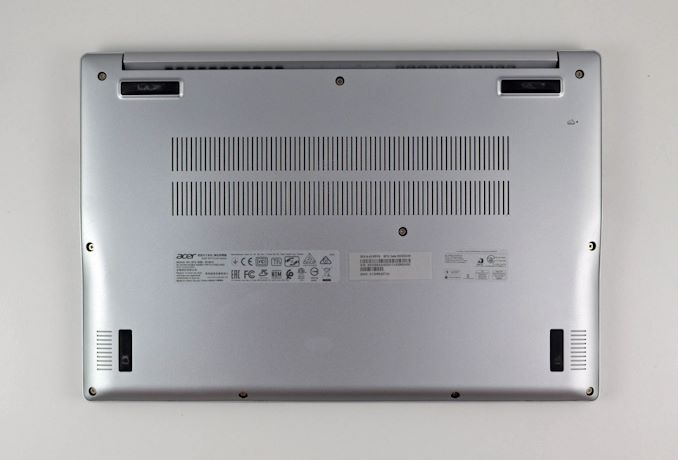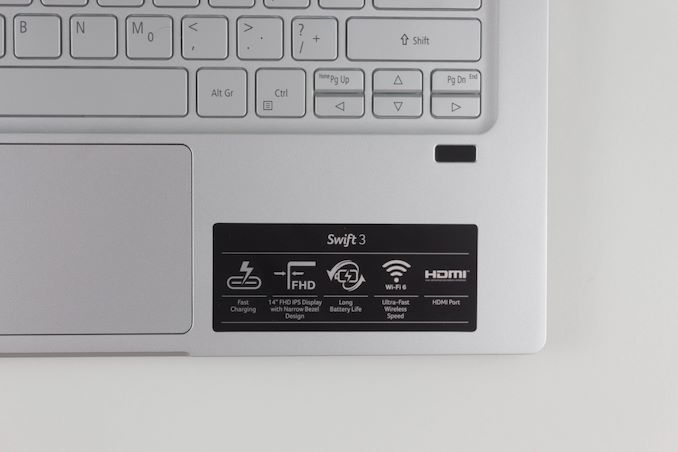The Acer Swift 3 SF314 Notebook Review: Swift Gets Swifter With Ryzen 4000
by Brett Howse & Andrei Frumusanu on May 5, 2020 8:00 AM ESTFinal Words
Although there are a few shortcomings on the new for 2020 Acer Swift 3, overall the company has done an excellent job on a lot of the key areas of this notebook. Considering the price of just $649, including 8 GB of RAM and a 512 GB NVMe SSD is very welcome, and having a processor that offers as much performance as the AMD Ryzen 7 4700U is the icing on the cake. The fact that everything is wrapped up in an attractive, sturdy aluminum shell really lets the Swift 3 punch above its weight.
AMD’s Ryzen 7 4700U is likely to be one of the more popular offerings in notebooks, and AMD has delivered. The new Zen 2 cores are much more competitive, and AMD has crammed eight cores onto this 15-Watt CPU. It is only in the last couple of generations that we saw quad-core processors in the 15-Watt range, but AMD has proven that they can make eight work in a limited power window. And while Intel appears to have a single-threaded performance advantage with their Sunny Cove CPU architecture, AMD’s Renoir simply overpowers Ice Lake with the number of full cores available.
The GPU performance is also excellent, and despite AMD cutting back on the numbers of compute units included in Renoir, they’ve made up for it not only with GPU frequency, but also with CPU performance helping feed the GPU. In all cases, the new 7 CU GPU in Renoir was able to outperform the 11 CU GPU in Picasso. Generally, a wider, slower GPU is going to offer better efficiency, but AMD has delivered the performance.
That performance does come at a cost though, and that is heat. The Acer Swift 3 could not keep up with the demands of the Renoir APU at full blast, and there was significant throttling when running at the Best Performance level in Windows 10. That is disappointing, because it prevents this notebook from being able to get the most out of the APU inside. If you were hoping to use the integrated Vega graphics for light gaming, be aware that you may run into heat issues.
It almost goes without saying that the display quality is also lacking. To hit this kind of a price point, certain areas were cut, and one of them was the display. The Acer Swift 3 does offer a 1920x1080 IPS panel, but the poor backlighting, lack of sRGB coverage, and poor color accuracy all make it a very mediocre display. It is not unexpected in this price range, but is one of the areas that reminds you why this laptop is priced where it is.
Despite the negatives, Acer has still delivered a winning combination with the Swift 3. It offers the same look, feel, and portability of a much more expensive design. The 83% screen to body ratio is not industry leading, but does offer the modern look of a thin-bezel design, and manages to make this 14-inch laptop feel much more compact than it is. It is also very light, at 2.65 lbs, making it very easy to travel with, if we ever get to travel again.
At a $649 MSRP, Acer has delivered a very solid value, thanks to the AMD Ryzen 7 4700U, 8 GB of DDR4-3200, and a 512 GB PCIe SSD. The Ryzen platform offers the same Modern Standby resume features as Intel now, so wakeup is instant. Battery life was very solid, and Acer has included features like an integrated fingerprint reader making sign-in a breeze.
Acer has been a great partner for AMD, and the new Swift 3 punches well above its weight. It is easy to be distracted by some of the top-end notebooks on the market, but if your budget is not quite there, you get a lot of the same qualities, but at a price that is very reasonable. The Acer Swift 3 SF314-42 is set to available in the early part of this month, so it should be available to purchase very soon.













191 Comments
View All Comments
lightningz71 - Tuesday, May 5, 2020 - link
It appears that the Acer Swift design philosophy just doesn't translate for anything that requires a high steady-state power draw and thermal load. The Swift had the same issues with the 2XXX and 3XXX series chips as well, so this is nothing new. This is something that Acer has deliberately chosen to make a design trade-off for: sacrifice some thermal dissipation ability to keep the product in the size class that it is intended for.It will be interesting to see the benchmarks on the 4500U in this platform. It was shown in benchmarks of previous versions of the swift that lower end APUs actually performed better in gaming than the top end parts because the system was better able to manage the thermal output and the APU was better able to keep consistent clocks. While the absolute performance was still lower than notebooks with better thermal management implementations, it was a better gaming performer than the top end SKU.
neblogai - Tuesday, May 5, 2020 - link
Generally, you are not complaining about Acer, but about U-series chips from both Intel or AMD. The philosophy of laptops with ~15W chips is that these chips are used in ultrabooks that are responsive and fast in short boosts, and not made for steady power (even if there are some premium devices that offer both).fmcjw - Tuesday, May 5, 2020 - link
The 2019 Swift 5 and LG Gram series were matched to the thermal promises of Intel 10nm chips that took 2 generations to arrive, and maybe 5nm AMD SoCs in 2021 since AMD decided to rush to market with last generation GPU architecture in early 2020. Perhaps with software or AI based optimization, there can be a more optimal mix of processes split between the CPU versus the GPU for best performance within thermal constraints. Not every task is as clear cut as gaming routines, where more of the work is performed more efficiently on the GPU. I'm not sure that will happen though, as such software optimization has the least return on investment outside cloud and data center applications. Not even Apple wants to do it for the 2020 Macbook Air, thermally crippling a fine Intel chip and resolving the issue by sticking a more powerful cooling solution in a Macbook Pro (and charge more).For 2020, Acer managed to get the Swift 3 down to 1.2kg from 1.45kg of the 2019 model through the use of aluminum AND magnesium (not just aluminum as the article states). The 2020 Swift 5 maintains a 1kg weight while including a rare-breed matte touch screen. The Swift 5 is the model you want to get for 100% sRGB at a $300 premium. I think the only reason these fine machines sell for $600 to $900 for a mid-range configuration is the thermally constrained performance of the more stubbornly ambitious SoCs.
Which if they can think outside the box can easily resolve by selling a fan-assisted cooling dock and unleash the full potential of the SoC we already paid for (and charge more).
Fulljack - Tuesday, May 5, 2020 - link
while Vega here is based on GCN 5 and not RDNA, it doesn't mean it's an outdated architecture. AMD did enhance the Vega arch for Ryzen 4000, with 56% improvement over Vega arch found in Ryzen 3000. overall, with enhanced arch, reduced core count, and higher clock, AMD did deliver 2020 Vega 8 that performs 28% better than 2019 Vega 11.https://www.anandtech.com/show/15324/amd-ryzen-400...
Oxford Guy - Thursday, May 7, 2020 - link
All irrelevant when the laptop's cooling is so pathetic:"The laptop really struggled with its thermals, dropping the framerate into single digits often. The device attempted to run at around 18 Watts of power draw, slightly over the 15 Watt TDP, but in fact only averaged around 8 Watts during this run."
csp4me - Tuesday, May 5, 2020 - link
Acer Swift 3 and 5 are in the market for lightweight, cool & quiet laptops within thermal constraints, thus ~ 18W tdp, and throttling under stress test.For the same budget of Acer Swift 5 ~ $900 you can find laptop models with the same quality display or better and also better thermals ~ 28W-35W at the expense of weight 1.3-1.4kg and noise/heat during heavy loads. Examples Lenovo Ideapad S540-13 both AMD or Intel, or Yoga Slim 7 both AMD or Intel.
psychobriggsy - Tuesday, May 5, 2020 - link
When you buy low power laptops - Y or U series TDPs - you are really looking out for these things1) Sustained Single Core Clock
2) Sustained All-Core Clock
3) Race-To-Sleep Single Core Turbo Boost (and the time it can sustain this)
4) Race-To-Sleep All-Core Turbo Boost (and the time it can sustain this)
1 and 2 are what your gaming sessions will occur in. 3 and 4 might help in some particularly CPU-heavy parts, but only for small periods of time.
This is the problem Intel have with their 14++++ chips - 1 and 2 cannot be raised in the TDP they are restricted to (unlike desktop, where they can simply lie about the figures, in a laptop this will affect battery life and be easily detected), so they hype 3 and 4 to compensate.
AMD on 7nm does well in all four measures, but you should never think you'll get long-term turbo clock performance from any mobile chip. I don't know if Renoir has a 4C turbo that can last longer than the 8C turbo for lightly threaded loads.
fmcjw - Tuesday, May 5, 2020 - link
Can a Y or U series SoC be considered the equivalent of an H series SoC internally, with a beefier cooling solution and reduced I/O capabilities externally? I imagine not just the I/O or cooler but also the capacitors and power circuitry need to be higher specified for the higher sustained load.It's just that few makers even try to create a balanced system around the U or Y series, letting Turbo Boost go wild to impress for the first minute or two, or restraint the system thermally to achieve longer battery life even when you can plug it in.
T1beriu - Tuesday, May 5, 2020 - link
>the mobile chips here only feature half the L3 cache compared to its desktop counterpartsSmall correction. Ryzen 4000 actually has a quarter.
ads295 - Tuesday, May 5, 2020 - link
Acer has consistently impressed me with their attention to detail. There are so many moronic OEMs that put in a single module of RAM but even my 2016 Acer E5-553-T4PT came with 2 modules of 2GB DDR4 RAM to enable the A10-9600P to run in dual channel mode.I suppose they don't get paid to debilitate AMD setups.